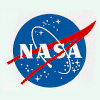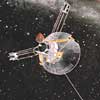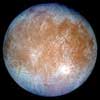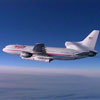|
Sunday:
June 10, 2001 | |
0342 GMT |
 |
Europe's Mars Express will investigate Phobos
Phobos, the tiny innermost moon of Mars, is to come under unprecedented scrutiny after Europe's mission to Mars goes into orbit around the Red Planet late in 2003.
 FULL STORY FULL STORY
 |  |

|
 |
Goldin tells graduates humans on Mars in 20 years
NASA administrator Dan Goldin told graduates of one of the nation's leading universities Friday that humans would walk on Mars within the next 20 years. Goldin described the unofficial but widely-accepted long-term goal of the agency's human spaceflight program.
 FULL STORY FULL STORY
 |  |

|
 |
Gamma-ray burst reveals secrets of host galaxy
Five years ago, astronomers knew almost nothing about gamma ray bursts. Now,
a team of observers has used a gamma-ray burst as a powerful tool to unveil
the nature of the galaxy in which it occurred, more than 7 billion light-
years away.
 FULL STORY FULL STORY
 |  |

|
 |
DAILY BRIEFING Other stories making news today
|
 |
Brightest quasars inhabit galaxies with star-forming gas clouds -- A team of scientists at the California Institute of Technology and the State University of New York at Stony Brook has found strong evidence that high-luminosity quasar activity in galaxy nuclei is linked to the presence of abundant interstellar gas and high rates of star formation.
|
 |
|
Saturday:
June 9, 2001 | |
0807 GMT |
 |
Ariane 4 rocket launches new era for Intelsat
A predawn launch of a European Ariane 4 rocket today delivered into space the first in a new series of communications satellites to beef up Intelsat's orbiting fleet with more powerful and higher capacity craft.
 FULL STORY FULL STORY
 MISSION STATUS CENTER MISSION STATUS CENTER
 |  |

|
 |
Next Pegasus rocket launch remains grounded
It will be June 20 at the earliest before NASA's HESSI solar imaging satellite is hauled into space by an Orbital Sciences Pegasus XL rocket as the investigation continues into last Saturday's X-43A launch failure, officials said Friday.
 FULL STORY FULL STORY
 |  |

|
 |
New X-ray window to the universe is opened
Using a telescope containing unique X-ray mirrors, a team from NASA's Marshall Space Flight Center in Huntsville, Ala., has obtained the world's first focused high-energy X-ray images of any astronomical object.
 FULL STORY FULL STORY
 |  |

|
 |
DAILY BRIEFING Other stories making news today
|
 |
Cosmos rocket is back -- A Russian Cosmos-3M rocket was successfully launched on Friday, marking the booster's return-to-flight after a failure last November.
|
 |
|
Friday:
June 8, 2001 | |
0630 GMT |
 |
Ariane 4 launch scrubbed
Arianespace has scrubbed this morning's scheduled launch of the Ariane 4 rocket carrying the Intelsat 901 telecommunications satellite. Officials called off the countdown due to unfavorable high-altitude winds.
 MISSION STATUS CENTER MISSION STATUS CENTER
 |  |

|
 |
Shuttle launch delayed amid station arm mystery
NASA officials have again postponed the launch of space shuttle Atlantis on the next international space station construction mission while engineers struggle to understand problems with the outpost's new robotic arm.
 FULL STORY FULL STORY
 |  |

|
 |
Spacewalk occurs inside space station Alpha
The first spacewalk staged from the international space station was successfully performed today as Russian cosmonaut Yuri Usachev and American astronaut Jim Voss manually repositioned a 150-pound, three-foot diameter docking mechanism.
 MISSION STATUS CENTER - live updates MISSION STATUS CENTER - live updates
 |  |

|
 |
Saturn's changing seasons
Looming like a giant flying saucer in our outer solar system, Saturn puts on a show as the planet and its magnificent ring system nod majestically over the course of its 29-year journey around the Sun. These Hubble images, captured from 1996 to 2000, show Saturn's rings open up from just past edge-on to nearly fully open as it moves from autumn towards winter in its Northern Hemisphere.
 FULL STORY FULL STORY
 |  |

|
 |
NASA gives official nod to robotic mission to Mercury
NASA has given the first Mercury orbiter mission the go-ahead to move into full-scale spacecraft development -- setting up the first trip to the Sun's closest neighbor in more than a generation. Launch of the MESSENGER probe is set for March 2004.
 FULL STORY FULL STORY
 |  |

|
 |
|
Thursday:
June 7, 2001 | |
1230 GMT |
 |
Investigators named to probe X-43A launch failure
NASA has announced the five-person accident investigation panel that will determine what caused the Orbital Sciences Pegasus booster with the agency's X-43A aircraft to malfunction during a botched launch Saturday.
 FULL STORY FULL STORY
 |  |

|
 |
NASA selects two Pluto mission proposals
NASA announced Wednesday that it had chosen two proposals for a mission to Pluto for additional study despite the fact that no funds for such a mission exist in the agency's budget for next year.
 FULL STORY FULL STORY
 |  |

|
 |
Senate report slams NASA management practices
A Senate committee report released this week -- entitled "Government at the Brink" -- sharply criticized NASA's handling of key programs, calling it one of the worst examples of mismanagement in the entire federal government.
 FULL STORY FULL STORY
 |  |

|
 |
Star factory near galactic center bathed in X-rays
Near the crowded core of the Milky Way galaxy, where stars shine so brightly and plentifully that planets there would never experience nighttime, astronomers have found a new phenomenon: a cauldron of 60-million-degree gas enveloping a cluster of young stars.
 FULL STORY FULL STORY
 |  |

|
 |
Pioneer 10 status check
New data from the Geiger Tube Telescope instrument aboard NASA's Pioneer 10 space probe has been analyzed. The report is cosmic ray intensity has continued to decrease. The craft is currently 7.34 billion miles from Earth.
 FULL STORY FULL STORY
 |  |

|
 |
DAILY BRIEFING Other stories making news today
|
 |
Iridium launches global data, Internet services -- Iridium Satellite LLC announced Wednesday the commercial availability of its mobile satellite data services, including dial-up connectivity and direct-Internet connections.
|
 |
|
Wednesday:
June 6, 2001 | |
0206 GMT |
 |
Wealth of black holes found in star-forming galaxies
NASA's Chandra X-ray Observatory has found new populations of suspected mid-mass black holes in several starburst galaxies, where stars form and explode at an unusually high rate. Although a few of these objects had been found previously, this is the first time they have been detected in such large numbers.
 FULL STORY FULL STORY
 |  |

|
 |
Method to madness of black hole, neutron star eruptions
In the fiery machinery of the night sky, where neutron stars and black
holes wrapped in binary systems can flare and burst randomly,
astronomers have uncovered a predictable mathematical pattern in the X-
ray light emitted over time.
 FULL STORY FULL STORY
 |  |

|
 |
Researchers seek ocean on Europa through its sounds
Acoustic techniques used by Massachusetts Institute of Technology researchers to explore the Arctic Ocean may help determine whether there is a vast liquid ocean under the ice blanketing Jupiter's moon, Europa.
 FULL STORY FULL STORY
 |  |

|
 |
Arianespace clears Ariane 4 rocket for Friday launch
After a three-month lull in flights, Arianespace has entered the final stretch of preparations for Friday's predawn launch of an Ariane 4 rocket carrying the Intelsat 901 telecommunications satellite.
 MISSION STATUS CENTER MISSION STATUS CENTER
 |  |

|
 |
|
Tuesday:
June 5, 2001 | |
0323 GMT |
 |
Search begins for cause of X-43A launch malfunction
Video shot during Saturday's doomed launch of a Pegasus booster with NASA's X-43A experimental aircraft shows what might be one of the rocket's aerosurfaces breaking off moments before the vehicle goes into an uncontrolled tumble through the sky.
 FULL STORY FULL STORY
 VIDEO OF LAUNCH FAILURE VIDEO OF LAUNCH FAILURE
 |  |

|
 |
Next Pegasus rocket launch delayed in X-43A aftermath
NASA has postponed this week's planned flight of the Pegasus rocket carrying a Sun-studying probe while investigators determine what went wrong during Saturday's X-43A launch that used a similar booster.
 FULL STORY FULL STORY
 |  |

|
 |
Astronomers discover extrasolar asteroid belt
Astronomers announced Monday that they had found evidence for what could be a belt of asteroids forming around another star, a discovery that may help them better understand how solar systems like our own form.
 FULL STORY FULL STORY
 |  |

|
 |
DAILY BRIEFING Other stories making news today
|
 |
Quiet times on Galileo probe -- Galileo, the spacecraft, is now settling into a three-week period of extreme rest, even while Galileo, the flight team, is gearing up in planning for the next flyby in early August.
|
 |
|
Monday:
June 4, 2001 | |
0314 GMT |
 |
British craft ends mission after missed rendezvous
The United Kingdom's first nanosatellite has failed in its daring rendezvous attempt with a Chinese craft, but scientists say the mission's other tests and demonstrations of nanotechnology were successfully completed.
 FULL STORY FULL STORY
 |  |

|
 |
Satellite formation flying concept becoming a reality
The intensive planning activities and calculations that are currently done in control rooms on Earth in preparation to maneuver Earth-orbiting research satellites are about to become a thing of the past. NASA's first-ever autonomous formation flying mission is now under way as part of the EO-1 satellite program.
 FULL STORY FULL STORY
 |  |

|
 |
DAILY BRIEFING Other stories making news today
|
 |
Gift of galaxies will fuel new findings -- Redshift data and spectra from the first 100,000 galaxies measured by the 2dF (Two-degree Field) Galaxy Redshift Survey will be released to the world astronomical community on June 30.
|
 |


 The Hubble Space Telescope's majestic view of the Eskimo Nebula. This spectacular poster is available now from the Astronomy Now Store.
The Hubble Space Telescope's majestic view of the Eskimo Nebula. This spectacular poster is available now from the Astronomy Now Store.